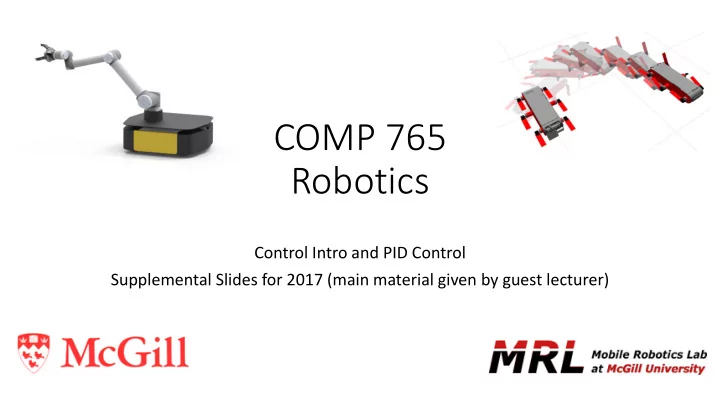

COMP 765 Robotics Control Intro and PID Control Supplemental Slides for 2017 (main material given by guest lecturer)
Outline • A few important concepts to warm up • PID control
Robotic Control
Control Formulation • We work at the level of dynamics, governed by the equations of motion of our robotic system: • A controller chooses u dependent on state and time to achieve: • Path following • Smooth pouring • Counter-balancing full body-weight to drill a smooth hole • Often a level below planning, which selects the series of states over time, x 1 , …, x n that form our control targets. Later we will see methods that fall in between these worlds.
Considerations from Control Theory • Depending on properties of system dynamics, we may not be able to choose x directly if the system is underactuated • As long as we can control the system from any initial state to any final state in a finite time, the system is controllable • As in RL, a system is observable if one can recover its state exactly from available measurements • Several time-response characteristics may be important: • Rise time • Settling time • Oscillation period
Control Theory Results • For some classes of systems, ideal constructive solutions: • As we will see: linear quadratic regulator produces optimal controller over all state space for linear dynamical systems • In other cases, analysis tools tell us what to hope for: • Stability analysis and basins of attraction • The above are mostly possible due to knowledge of dynamics and reward. What if we don’t know this (not at all, or only with error)? • Robust control, system identification, LQG • The most room here for new algorithms!
State and control of a cartpole State = [Position and velocity of cart, orientation and angular velocity of pole] Control = [Horizontal force]
Cartpole properties • Theta joint lacks a motor making this system underactuated • We must sometimes sacrifice desirable cart position in order to "catch" the pole and right it • This coupling comes from the dynamics equations • Two canonical tasks: • Swing-up • Balancing
Proportional Integral Derivative (PID) Control
Typical PID Responses Increasing P leads to faster D reduces both responsiveness and oscillation motion, but eventually oscillates I reduces steady-state errors
How to tune the PID? • Ziegler-Nichols heuristic: • First, use only the proportional term. Set the other gains to zero. • When you see consistent oscillations, record the "ultimate" proportional gain and the oscillation period Ziegler, J.G & Nichols, N. B. Optimum settings for automatic controllers. Transactions of the ASME, 1942!
More tuning and more • In practice, much time is still spent on tuning: • Ziegler-Nichols is analytically optimized to give a "quarter wave" overshoot • Other desired properties can be achieved by similar analysis • Modern learning methods can be applied: • "Twiddle" recommended by Sebastian Thrun • Bayesian Optimization • It doesn't always work (well): the devil is in the details • Computing derivatives for practical signals requires smoothing • What happens to the integrator if the system is stuck (or off)?
Example from my research
PID accomplishments • The most widely used controller in practice • E.g., airplane autopilots, self-driving cars, plant control systems • A data-driven method (machine learning was hot in 1860!), does not require knowledge of system dynamics equations • Often robust across system conditions
Why not use PID? • The gains for PID are good for a small region of state-space. • System reaches a state outside this set becomes unstable • PID has no formal guarantees on the size of the set • We would need to tune PID gains for every control variable. • If the state vector has multiple dimensions it becomes harder to tune every control variable in isolation. Need to consider interactions and correlations. • We would need to tune PID gains for different regions of the state-space and guarantee smooth gain transitions • This is called gain scheduling, and it takes a lot of effort and time
Why not use PID? Automated algorithms for these next • The gains for PID are good for a small region of state-space. • System reaches a state outside this set becomes unstable • PID has no formal guarantees on the size of the set • We would need to tune PID gains for every control variable. • If the state vector has multiple dimensions it becomes harder to tune every control variable in isolation. Need to consider interactions and correlations. • We would need to tune PID gains for different regions of the state-space and guarantee smooth gain transitions • This is called gain scheduling, and it takes a lot of effort and time
Next time: Optimal Control • Formulate control problem as optimization of a cost function given some form of knowledge about the system • This is equivalent to an MDP with continuous state and actions
Recommend
More recommend